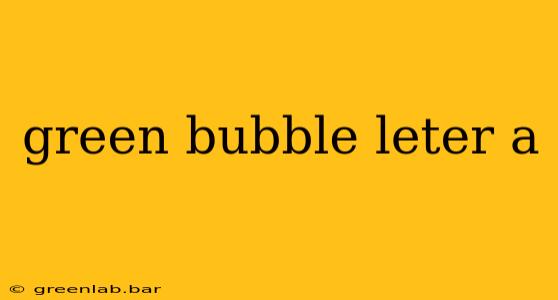The ubiquitous green bubble. For many iPhone users, it's a symbol of exclusion, a visual reminder that their message isn't enjoying the full, encrypted glory of iMessage. But what exactly is a green bubble, and why does it appear? This guide dives deep into the technicalities and social implications of this seemingly simple visual cue.
Understanding iMessage and SMS/MMS
Before we tackle the green bubble mystery, let's establish the foundation. iMessage is Apple's proprietary messaging service, integrated directly into your iPhone, iPad, and Mac. It uses the internet (data) to send messages, offering features like read receipts, typing indicators, and high-quality image and video sharing. Crucially, iMessage employs end-to-end encryption, protecting your messages from prying eyes, including Apple itself.
SMS (Short Message Service) and MMS (Multimedia Messaging Service) are older, standard messaging protocols. They rely on your cellular carrier's network and don't inherently offer the same level of encryption as iMessage. This is where the green bubble comes into play.
Why Do Green Bubbles Appear?
A green bubble signifies that your message was sent as an SMS/MMS message, not an iMessage. This happens when:
- The recipient doesn't have an iPhone or isn't using iMessage. If you're messaging someone with an Android phone, a Windows Phone, or an older iPhone not using iMessage, your message will default to SMS/MMS.
- The recipient's iMessage is turned off or having connectivity issues. Even if they have an iPhone, if iMessage isn't enabled or they lack internet access, your message will fall back to SMS/MMS.
- iMessage is temporarily unavailable. If there's a service interruption with iMessage, your messages might revert to SMS/MMS.
The Technical Details: A Deeper Dive
The transition between iMessage (blue bubbles) and SMS/MMS (green bubbles) is automatic. Your iPhone attempts to send the message via iMessage; if this fails, it switches to SMS/MMS as a backup. This seamless fallback ensures your messages always get delivered, even if iMessage isn't immediately available.
The Social Significance of the Green Bubble
Beyond the technical aspects, the green bubble has taken on a surprising social significance. For some, it's become a subtle social marker, reflecting the type of device and operating system a person uses. This has led to a sometimes-unintentional social hierarchy, with blue bubbles (iMessage) often associated with Apple users and green bubbles (SMS/MMS) associated with Android users.
This association can lead to perceptions—sometimes accurate, sometimes inaccurate—about socioeconomic status or technological savviness. It's crucial to remember that the technology behind the bubble color is simply a technical fallback mechanism, and it shouldn't be used to make judgments about individuals.
Troubleshooting Green Bubbles
If you're consistently seeing green bubbles when messaging someone you expect to be using iMessage, try these troubleshooting steps:
- Ensure iMessage is enabled: Check your device's settings to confirm that iMessage is turned on.
- Verify internet connectivity: Make sure both you and the recipient have a stable internet connection.
- Restart your device: A simple restart can often resolve temporary glitches.
- Check for iOS updates: An outdated iOS version might interfere with iMessage functionality.
Conclusion: Beyond the Color
The green bubble is more than just a visual indicator; it's a glimpse into the complexities of messaging protocols and their often-unintended social ramifications. Understanding the technology behind it can help us interpret its appearance accurately and avoid making unwarranted assumptions based on a simple color change. Ultimately, focusing on the content of the message, rather than its color, fosters more meaningful communication.

